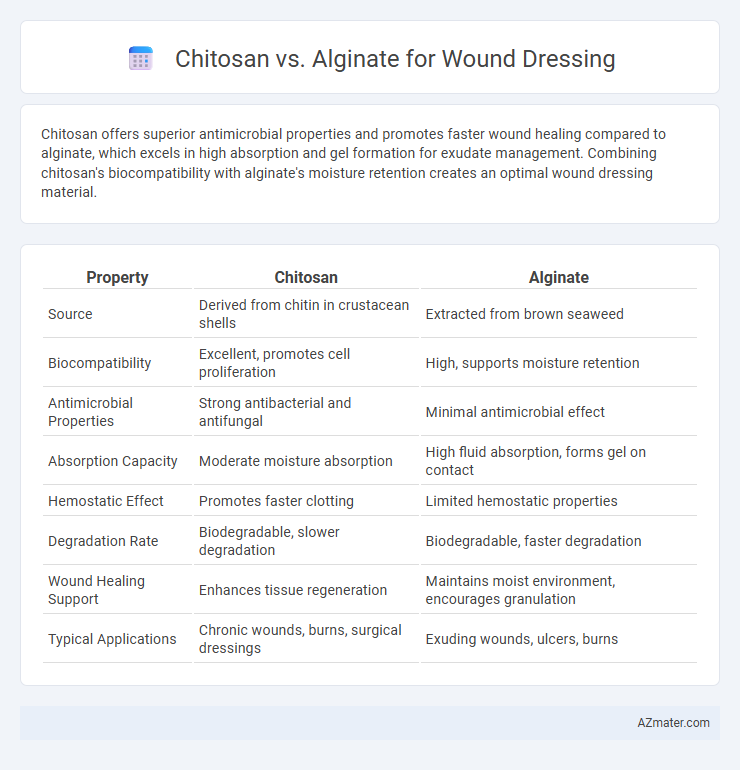Chitosan offers superior antimicrobial properties and promotes faster wound healing compared to alginate, which excels in high absorption and gel formation for exudate management. Combining chitosan's biocompatibility with alginate's moisture retention creates an optimal wound dressing material.
Table of Comparison
| Property | Chitosan | Alginate |
|---|---|---|
| Source | Derived from chitin in crustacean shells | Extracted from brown seaweed |
| Biocompatibility | Excellent, promotes cell proliferation | High, supports moisture retention |
| Antimicrobial Properties | Strong antibacterial and antifungal | Minimal antimicrobial effect |
| Absorption Capacity | Moderate moisture absorption | High fluid absorption, forms gel on contact |
| Hemostatic Effect | Promotes faster clotting | Limited hemostatic properties |
| Degradation Rate | Biodegradable, slower degradation | Biodegradable, faster degradation |
| Wound Healing Support | Enhances tissue regeneration | Maintains moist environment, encourages granulation |
| Typical Applications | Chronic wounds, burns, surgical dressings | Exuding wounds, ulcers, burns |
Introduction: The Importance of Advanced Wound Dressings
Advanced wound dressings play a critical role in enhancing the healing process by providing optimal moisture balance and protecting against infections. Chitosan and alginate are two biomaterials widely used due to their biocompatibility, biodegradability, and antimicrobial properties. Chitosan promotes hemostasis and accelerates tissue regeneration, while alginate excels in absorbing exudate and maintaining a moist wound environment, making both essential in modern wound care management.
Chitosan Overview: Source, Structure, and Key Properties
Chitosan, derived from the deacetylation of chitin found in crustacean shells, is a biopolymer characterized by its linear polysaccharide structure composed of D-glucosamine and N-acetyl-D-glucosamine units. Key properties include its biocompatibility, biodegradability, antimicrobial activity, and hemostatic ability, making it highly effective in wound dressing applications. These features enhance tissue regeneration, reduce infection risks, and promote faster wound healing compared to alginate dressings.
Alginate Overview: Composition and Unique Characteristics
Alginate wound dressings are primarily composed of calcium and sodium salts derived from brown seaweed, offering exceptional biocompatibility and high absorbency. Their unique gel-forming ability upon contact with wound exudate creates a moist healing environment that promotes tissue regeneration and minimizes infection risk. The porous structure of alginate fibers also facilitates oxygen permeability and supports hemostasis, making it ideal for moderate to heavily exuding wounds.
Mechanism of Action: How Chitosan Heals Wounds
Chitosan accelerates wound healing by promoting hemostasis through platelet aggregation and stimulating macrophage activation, which enhances tissue regeneration. Its inherent antimicrobial properties inhibit bacterial growth, preventing infections and reducing inflammation at the wound site. Additionally, chitosan's biocompatible and biodegradable nature supports cell proliferation and extracellular matrix formation, facilitating faster tissue repair compared to alginate dressings.
Mechanism of Action: Alginate’s Role in Wound Healing
Alginate in wound dressings functions by forming a gel upon contact with wound exudate, which maintains a moist environment essential for cellular migration and tissue regeneration. Its calcium ions exchange with sodium ions in wound fluid to facilitate hemostasis and promote fibroblast proliferation. Alginate also supports bioactive molecule retention, enhancing growth factor activity and accelerating the overall wound healing process.
Biocompatibility and Safety Comparison
Chitosan and alginate are both highly biocompatible materials frequently used in wound dressings, with chitosan exhibiting inherent antimicrobial properties that enhance safety by reducing infection risk. Alginate, derived from seaweed, offers excellent hemostatic capabilities and maintains a moist wound environment, promoting healing while showing minimal cytotoxicity. Comparative studies highlight chitosan's superior biodegradability and lower allergenic potential, whereas alginate is preferred for its strong gel-forming ability and high absorption, balancing safety and efficacy across various wound types.
Antimicrobial and Bioactive Effects
Chitosan exhibits strong antimicrobial properties due to its polycationic nature, effectively disrupting bacterial cell membranes and promoting faster wound healing through enhanced bioactivity. Alginate, derived from brown seaweed, provides excellent moisture retention and maintains a conducive environment for cell proliferation but has inherently weaker antimicrobial effects unless combined with antimicrobial agents. The bioactive advantage of chitosan lies in its ability to stimulate fibroblast proliferation and collagen synthesis, making it superior for infected or chronic wound management compared to alginate-based dressings.
Absorbency and Moisture Management
Chitosan exhibits high absorbency due to its porous structure, effectively managing wound exudate while maintaining a moist environment crucial for healing. Alginate dressings excel in moisture retention by forming a gel upon contact with wound fluids, promoting optimal hydration and minimizing maceration risk. Both materials offer superior moisture management, but chitosan's antimicrobial properties further enhance its suitability in wound care.
Clinical Applications and Efficacy Studies
Chitosan and alginate are widely studied biomaterials for wound dressings due to their biocompatibility, biodegradability, and antimicrobial properties. Clinical applications demonstrate chitosan's superior hemostatic ability and enhanced wound healing rates, particularly in chronic and diabetic ulcers, while alginate excels in managing exudate and maintaining a moist wound environment, beneficial for heavily exuding wounds. Efficacy studies highlight chitosan's promotion of fibroblast proliferation and collagen deposition, contrasting with alginate's effective gel formation and absorption capacity, making both materials critical in tailored wound care management.
Future Perspectives and Innovation in Wound Care
Chitosan and alginate are revolutionizing wound care through innovations in biocompatible, antimicrobial, and biodegradable materials that accelerate healing and reduce infection. Future perspectives highlight the integration of smart dressings embedded with sensors and drug delivery systems, leveraging chitosan's hemostatic properties and alginate's gel-forming ability for personalized wound management. Advances in nanotechnology and tissue engineering promise enhanced regeneration and real-time monitoring, positioning these polysaccharides as pivotal components in next-generation wound dressings.

Infographic: Chitosan vs Alginate for Wound dressing
 azmater.com
azmater.com